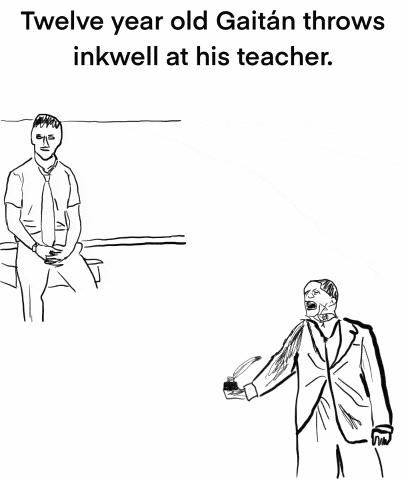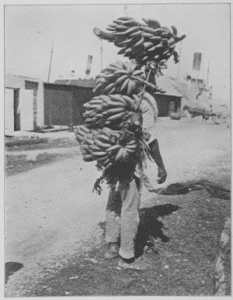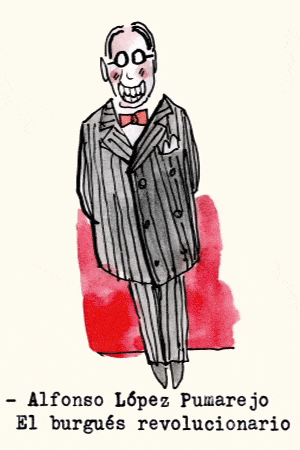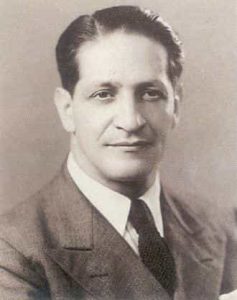¡Yo Soy Un Pueblo! Colombian History Pt. 5

Justin Hauver
This is the fifth part of a series on Colombian history written to help me make sense of the country’s past. Education research (all research?) depends on an awareness of context, including historical context. Besides, I was curious and I like reading about history.
“¡Yo no soy un hombre, yo soy un pueblo!” I am not a man, I am a people! Jorge Eliécer Gaitán, the man who embodied the hopes of so many Colombians, was shot dead on his way to lunch on April 9, 1948. The community that Gaitán represented died with him, unraveling, fragmenting, and descending into La Violencia. Riots started immediately in Bogotá and lasted into the night, resulting in as many as 3000 deaths and widespread property destruction that forever altered the development of the city. El Bogotazo or El Nueve de Abril (as it is called to emphasize its scope beyond the capital) echoed across the country, driving political violence to terrifying levels. There were over 200,000 political murders in the years that followed.

Gaitán lives on in the psyche of many as a pivotal figure. Recently, our tour guide to several sites around Bogotá repeatedly demarcated Colombian history before and after the murder of Gaitán. According to him, before the city center was in La Candelaria (now the old city center) but the riots and instability following the assassination caused many businesses to move into new areas. Before, the transit system was public but after the fall of the socialist figurehead, privatization gained the advantage, allowing companies like the TransMilenio to dominate. Before, there was more political space for leftist ideologies but the death of the leftist leader pushed those ideas out of the mainstream and into the countryside, where the most marginalized began taking up arms, forming self-defense groups, and organizing into guerrilla movements. And so on.
More than a man, or even a pueblo, Gaitán can be understood as a kind of prism that absorbed and bent Colombian history, illuminating the different currents that were already there. The 1800s were defined by revolution and the violent construction of the Conservative/Liberal framework that served the upper classes. Then, with the establishment firmly in place, the 1900s brought new challenges to the oligarchic power structure itself. A man of his time, Gaitán lived as a provocation to the oligarchy and he died as a hero to many.
“Queremos ser cerebros iluminados y ardidos por el fuego de nuestro corazón.”
“We want our minds illuminated and inflamed by the fire of our heart.” Gaitán was known for fiery rhetoric that galvanized audiences. But, though his polarizing speeches were not out of place in his adulthood, the 20th century in Colombia began with more superficially soothing approaches.
Gaitán was born in Bogotá around the turn of the century to precariously middle class parents who were members of the Liberal Party. His indigenous ancestry and his family’s politics set him opposed to the ruling party right from birth. The Conservative Party had won the War of a Thousand Days in 1902, allowing them to preserve the Constitution of 1886 and to maintain their hold on power for several more decades. It’s no wonder that Gaitán chafed against traditional authority. He was even expelled after he threw an inkwell at a teacher. This subversive spirit would ultimately serve him well as a talented orator who channeled the struggle against the status quo to create a pueblo.
The first Conservative president after the Thousand Days’ War was Rafael Reyes. In a move that won bipartisan support, he dissolved the homogeneously Conservative congress and convened a new National Assembly that was 1/3 Liberals, who were picked by him. To return the favor, the National Assembly named Reyes president for the next 10 years, putting him on the path towards dictatorship. At first, this didn’t seem to bother anyone too much. Reyes was relatively calm and benevolent, especially after the devastating war. Eventually, however, he started using repressive tactics and allowed corruption among friends and family to grow out of hand. By 1909 it was clear that he had lost the support of the upper class, so he fled to France.

The next president, Carlos E. Restrepo, was another moderate who attempted to govern under a “Republican Union” that included centrist politicians from both parties. According to La Biblioteca Nacional de Colombia, Restrepo was likely the first Colombian president to be both “peaceful and democratic,” a man whose government “tried to establish tolerance in Colombia for the first time since Spaniards dressed in iron stepped foot on Caribbean beaches” (my translation). He warned against the “old and cherished hatreds” held by Conservatives and Liberals, and he worked to mend those divisions.
Ten years of relative peace, however, was enough time for partisan zeal to recover. The fires of the heart were rekindled and from 1914 to 1930, Conservatives stopped reaching across the aisle and reverted to their traditional positions, especially in the area of religion. The archbishop of Bogotá was endowed with the power to choose presidents. His choices, supported in pulpits across the country, invariably won the elections (perhaps also with some fraud).
“Nosotros no decimos que el hombre debe ser un esclavo de la economía, decimos que la economía debe estar al servicio del hombre”
“We don’t say that man should be a slave to the economy, we say that the economy should serve man.” The Conservative position was bolstered by economic prosperity, at least for some. During World War I, increased demand for troops caused coffee prices to rise and they continued to rise even after the war, making the crop Colombia’s most valuable export in the 1920s. Additionally, in 1921 the US and Colombia finally signed the Treaty of Urrutia-Thomson to formalize the independence of Panamá along with US claims over the canal. In return, Colombia was paid $25 million, an immense sum for the time that led to la danza de los millones. Funds were channeled into public work projects, debt repayment, and corruption. The wealth that came with the roaring 20s made unabashedly partisan Conservative rule palpable to Colombians, at least for a while.

The riches generated by banks and businesses during the 1920s, however, did not translate to better living conditions for many. In fact, Gaitán first gained notoriety as a Congressman in the fallout of the Banana Massacre of 1928. Colombian workers for the US-owned United Fruit Company went on strike in November of that year to demand, among other things, a 6 day work week and payment in money rather than in company store vouchers. The US government called the workers communists and threatened to send in the Marines if Colombia did not protect United Fruit’s interests. In December, the Colombian army moved in with machine guns and fired into masses of workers and their families. Estimates of the death toll range from 47 to 2000. Gaitán denounced the Conservative government as a servant to US interests and began to gain a massive following.
The Liberal Party as a whole was not far behind Gaitán. Both were strongly influenced by the socialist and communist thinking that exploded across Europe during and after WWI. Gaitán even wrote his master’s thesis on socialism in Colombia. In the Liberal Party itself, there was a reorganization and a reorientation away from classical liberal, free market policies and towards more democratic socialist ideas aimed at regulating business, protecting unions, and providing a social safety net. During the same time, Colombia’s population had doubled, with the biggest increases in urban areas. This growing class of industrial workers was more naturally aligned with Liberal Party policies.
Additionally, the Great Depression of 1929 brought coffee prices and the Colombian economy as a whole crashing down. And on top of it all, the conservatives were dealing with internal disagreements that led to split support for different candidates. Demographics, depression, and division coalesced to end nearly 50 years of Conservative dominance in 1930. Liberals glided into power on a wave of hope and change. Sounds kinda familiar.
“Pueblo por la derrota de la oligarquía, ¡a la carga!”
“People for the defeat of the oligarchy, charging!” Unsurprisingly, the Liberals did not lead a charge against the old framework of legitimacy and violence that protected upper class interests. Instead, Liberals tried to govern a moderate, mixed government, this time called la Concentración Nacional. Dreams of a more just Colombia were deferred, to the disappointment of working class Liberal voters.
But by the 1934 Conservative leader Laureano Gómez had pulled his party out of congress, hurling accusations of fraud and injustice as they left. In theory, this should have given President Alfonso López Pumarejo a clear path forward to carry out his Franklin D. Roosevelt / New Deal inspired plan called la Revolución en Marcha. López wanted to reform the conservative constitution, carry out actually meaningful agrarian reform, protect workers’ rights, reform education, and much more. In practice, however, the Liberal Party was as much beholden to the interests of the rich as the Conservative Party. Large landowners in the countryside and big businesses in the cities flexed their power to frustrate much of López’s agenda. By the end of his term in 1938, he was forced to announce a pause in his reforms. The challenge to oligarchy was neutralized.
The next president was a Liberal moderate who did not pursue la revolución en marcha. And even when López regained the presidency in 1942, he did not really try to pursue his old platform. Like Simón Bolívar more than a century before, it seems that López resigned himself to the idea that Colombia was not ready for sweeping changes. There would be no push to transform the Colombian framework into something more just for the majority. López resigned early, in 1945, after a term marred by his own kidnapping in an attempted coup, scandals, and his wife’s cancer.

“El pueblo es superior a sus dirigentes.”
“The people are better than their leaders.” Gaitán never faltered in his critiques of the government, whether it was nominally Liberal or Conservative. In 1933, he even formed the Unión Nacional Izquierdista Revolucionaria before eventually reconciling with the Liberal Party and rejoining their ranks the following year. In speeches that denounced liberal and conservative oligarchs alike, he gave voice to the vast segments of society that were disappointed with the lack of real reform and oppressed to the point of desperation.
Riding a wave of discontent with the status quo, Gaitán ran as a Liberal in the presidential elections of 1946. Unfortunately, the Liberal Party vote was split between him and a more right-leaning candidate. López refused to endorse either Gaitán, called “el negro” due to his indigenous ancestry, or his opponent. Like the Conservatives 16 years before, the divided vote cost the Liberals the election.
Though the dates are inexact, many historians argue that La Violencia began in the wake of the 1946 presidential election. Liberal working class people, disappointed time and again with the failures of Liberal presidents, lashed out at the new Conservative government, which brought absolutely no hope of meaningful reforms. In fact, at the advice of the World Bank, President Mariano Opsina Pérez turned away from attempts to improve the quality of life in rural areas in favor of promoting urban industrialization (without strong protections for workers). New levels of hopelessness brought increased violence.
Conservatives had also won power despite being in the minority nationwide, as was clearly demonstrated by the Liberal majority in congress. And though the President Ospina Pérez sought to govern in a bipartisan coalition, the leader of the party, Laureano Gómez, was a fascist admirer who had no qualms about sowing violence to stay in power. Around 14,000 people were killed for political reasons in 1947. Most of the instability was in rural, marginalized communities: “the violence pitched Liberal peasant against Conservative peasant” (Bushnell, 206).
“…la oligarquía no me mata, porque sabe que si lo hace el país se vuelca y las aguas demorarán cincuenta años en regresar a su nivel normal.”
“…the oligarchy won’t kill me because they know that if they do the country will turn upside down and it will take 50 years for the water to return to a normal level.” In retrospect, Gaitán’s apocalyptic prophesy seems optimistic. We do not know why he was shot dead. We are not even sure if the man that was beaten to death and strung up in La Plaza de Simón Bolívar, Juan Roa Sierra, was the actual murderer. Conspiracy theories abound.

We do know that Gaitán was immensely popular, a gifted orator who ignited the hopes of those left largely unserved in Colombian society. He was a clear favorite to win the presidency in the next elections. But it is less clear what reforms a President Gaitán would have been able to bring to the country. The Colombian establishment, born of revolution and violence, had proven itself resilient and able to absorb challenges from López’s Revolución en Marcha and others.
More than a story about a supposed “great man” in history, Gaitán embodied the pueblo, its context, its hopes, and its approaching future. His murder did not necessarily cause the violence (which had started two years before), but his assassination did manifest the brutality that had been brewing for decades, even centuries.
Sources
The Making of Modern Colombia: A Nation in Spite of Itself by David Bushnell
Magdalena: River of Dreams by Wade Davis
Between Legitimacy and Violence by Marco Palacios
There Are No Dead Here: A Story of Murder and Denial in Colombia by Maria McFarland Sánchez-Moreno
La Biblioteca Nacional de Colombia – https://bibliotecanacional.gov.co/es-co/proyectos-digitales/historia-de-colombia/libro/capitulo10.html
Various articles.
Note: All views expressed are my own, they do not represent the Fulbright or any other organization.
One Response